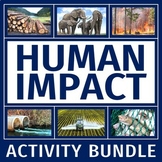Human Impact on the Environment Water Pollution Activity Stations Data Analysis
Flying Colors Science
4.8k Followers
Grade Levels
7th - 10th
Subjects
Resource Type
Standards
NGSSHS-ESS3-2
NGSSMS-ESS3-4
NGSSMS-ESS3-3
Formats Included
- PDF
- Google Apps™
Pages
12 pages
Flying Colors Science
4.8k Followers

Includes Google Apps™
The Teacher-Author indicated this resource includes assets from Google Workspace (e.g. docs, slides, etc.).
What educators are saying
My students enjoyed reading this and the questions were well written. Great use of time in class or could be used as a sub plan!
Great way for students to analyze the impact of water pollution and it forces students to use and analyze data. I will use this again next year.
Also included in
- Never search for "something to do tomorrow" ever again! This bundle contains PRINT AND GO lessons, NO PREP activities, LOW PREP labs, and ENGAGING articles to supplement and thoroughly enhance an Earth and space science course. Every included resource is easy to implement, standards-based, and high-Price $399.99Original Price $649.02Save $249.03
- SAVE 30% OFF LIST PRICES! Engage students with CRITICAL THINKING and DATA ANALYSIS as you cover many aspects of pollution:Air Pollution (Information Stations)Water Pollution (Practice Data Analysis)Land Pollution (Practice Graphing)Basics of Biomagnification (Engaging Text and Questions)IndividualPrice $14.99Original Price $21.96Save $6.97
- SAVE 35% off list prices! Engage students with CRITICAL THINKING as you teach them about how humans have impacted ecosystems around the world. The 12 included resources provide fun, NGSS-based activities for each of the following topics:Habitat Destruction Overharvested ResourcesInvasive SpeciesWatPrice $39.99Original Price $62.90Save $22.91
Description
Engage students with CRITICAL THINKING and DATA ANALYSIS as they learn about different aspects of water pollution!
⭐ Get this activity at a huge discount in our Pollution Activities Set! ⭐
Eight print-and-go stations are included, each with a different focus. Station cards include text passages to read, data and graphs to analyze, or a map to interpret. As they move through the stations, students answer questions on a corresponding student worksheet.
Both PRINT and DIGITAL versions are included!
Water Topics (1 Station Each):
- What is Water Pollution?
- Nitrogen Pollution
- Phosphorous Pollution
- Oil Spills
- Trash and Microplastics
- Acid Rain
- Contaminated Drinking Water
- Other Types of Water Pollution (thermal, particulate, radioactive)
This Resource Includes:
- 8 Station/Activity Cards (print one for each station)
- Student Worksheet (2 pages front/back)
- Answer Key
- Google Slides version of activity
This product has companion resources:
- Land Pollution: Graphing Garbage
- Air Pollution Stations
- Engaging "Flying Cats" Biomagnification Lesson (middle school level)
Teacher Notes:
- Please note: this resource is not editable.
- The station cards look best when printed in color (you'll only need one color copy for each station), but they can be printed in black and white if necessary.
- No prior knowledge is required - all information in the questions comes directly from the information provided.
- Go paperless! This activity includes a version in Google Slides.
⭐⭐⭐ Click here to get 5 FREE EARTH & SPACE SCIENCE lessons! ⭐⭐⭐
Total Pages
12 pages
Answer Key
Included
Teaching Duration
N/A
Report this resource to TPT
Reported resources will be reviewed by our team. Report this resource to let us know if this resource violates TPT’s content guidelines.
Standards
to see state-specific standards (only available in the US).
NGSSHS-ESS3-2
Evaluate competing design solutions for developing, managing, and utilizing energy and mineral resources based on cost-benefit ratios. Emphasis is on the conservation, recycling, and reuse of resources (such as minerals and metals) where possible, and on minimizing impacts where it is not. Examples include developing best practices for agricultural soil use, mining (for coal, tar sands, and oil shales), and pumping (for petroleum and natural gas). Science knowledge indicates what can happen in natural systems—not what should happen.
NGSSMS-ESS3-4
Construct an argument supported by evidence for how increases in human population and per-capita consumption of natural resources impact Earth’s systems. Examples of evidence include grade-appropriate databases on human populations and the rates of consumption of food and natural resources (such as freshwater, mineral, and energy). Examples of impacts can include changes to the appearance, composition, and structure of Earth’s systems as well as the rates at which they change. The consequences of increases in human populations and consumption of natural resources are described by science, but science does not make the decisions for the actions society takes.
NGSSMS-ESS3-3
Apply scientific principles to design a method for monitoring and minimizing a human impact on the environment. Examples of the design process include examining human environmental impacts, assessing the kinds of solutions that are feasible, and designing and evaluating solutions that could reduce that impact. Examples of human impacts can include water usage (such as the withdrawal of water from streams and aquifers or the construction of dams and levees), land usage (such as urban development, agriculture, or the removal of wetlands), and pollution (such as of the air, water, or land).








